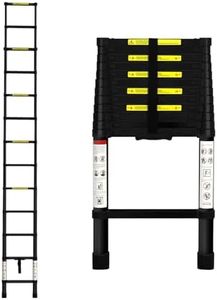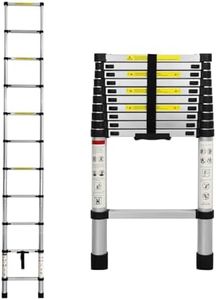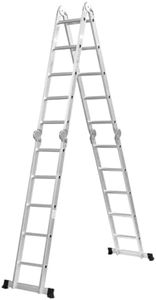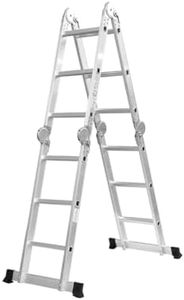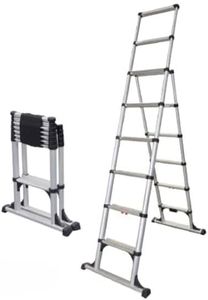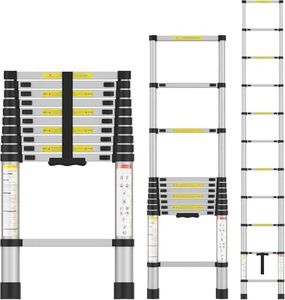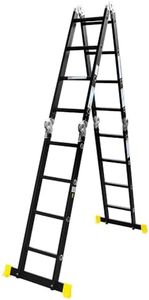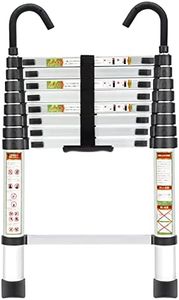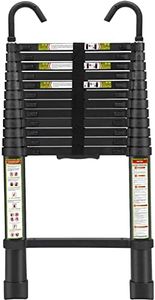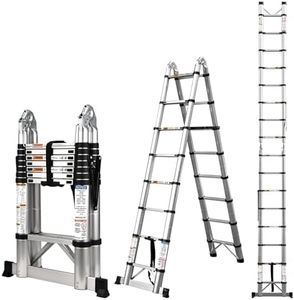We Use CookiesWe use cookies to enhance the security, performance,
functionality and for analytical and promotional activities. By continuing to browse this site you
are agreeing to our privacy policy
10 Best Extension Ladders
From leading brands and best sellers available on the web.Buying Guide for the Best Extension Ladders
Choosing an extension ladder is all about finding a safe and reliable ladder that matches the tasks you'll tackle most often. Start by considering where and how you'll use it—indoors for occasional repairs, outdoors for roof access, or perhaps for professional work at varying heights. Think about mobility, storage space, and how often you'll need to move or transport the ladder. Safety always comes first, so pay close attention to ratings and stability features, making sure the ladder is suited to your environment and your needs.Maximum Reach HeightMaximum reach height is the total height you can safely reach when standing on the ladder, which considers both the ladder's length and the average standing height of the user. This specification is important because it determines whether the ladder will be tall enough for your intended jobs, like cleaning gutters or painting high walls. Extension ladders come in various sizes: shorter ones (16–20 feet) are suited for simple indoor tasks, mid-range ladders (24–28 feet) work for single-story rooftops and most around-the-house needs, while longer ladders (32 feet or more) are better for two-story houses or professional use. Always choose a ladder that provides a safe and comfortable reach for your usual projects—avoid standing on the very top rungs to maximize safety, so pick a ladder that's a bit taller than you think you'll need.
Load Capacity (Duty Rating)Load capacity, also known as duty rating, is how much total weight a ladder can safely hold—including your body weight, tools, and materials. It's crucial because using a ladder not rated for your weight can lead to dangerous accidents. Ladders are categorized by their ratings: light duty (up to 200 lbs), medium duty (up to 225 lbs), heavy duty (up to 250 lbs), and extra heavy duty (300 lbs or more). Match your usual gear and weight to the appropriate rating—if you often carry heavy tools or supplies while on the ladder, choose one with a higher load capacity for added security.
MaterialExtension ladders are commonly made from aluminum, fiberglass, or wood. This matters for both weight, durability, and safety. Aluminum is lightweight and easy to carry but conducts electricity, making it unsuitable for electrical work. Fiberglass is heavier but doesn't conduct electricity, making it safer around power lines and more durable for outdoor conditions. Wood is less common today, typically heavier and can warp over time if exposed to moisture, but it doesn't conduct electricity either. Choose the material depending on whether you'll be moving the ladder a lot, storing it outdoors, or working near electricity.
Number of SectionsLadders can come in two or more sections that slide to extend or collapse. The number of sections affects portability and storage—more sections generally mean the ladder collapses down smaller, making it easier to transport and store, though it may be slightly heavier or have more moving parts. If you need a tall ladder but have minimal storage space or need to transport it often, look for one with more sections. For basic home use, two-section ladders are often sufficient and simpler to operate.
Stabilizing FeaturesStabilizing features like wide, slip-resistant feet, stabilizer bars, or end caps help keep the ladder secure and steady while you’re climbing. These are important for your safety, especially if you plan to set the ladder up on uneven ground or work at greater heights. Ladders with added stabilization are less likely to tip over or slip. Consider these features if you’ll use the ladder outdoors or on surfaces that aren’t perfectly flat—your safety may depend on it.
Ease of AdjustmentEase of adjustment refers to the mechanism used to extend and lock the ladder in place. Smooth, reliable adjustment is important for both safety and convenience. Some ladders have rope-and-pulley systems, while others use manual rung locks or quick-latch designs. For occasional home use, simple locking systems are often enough, but if you adjust your ladder frequently, look for a model with easy-to-use, sturdy locking mechanisms to save time and reduce frustration.
